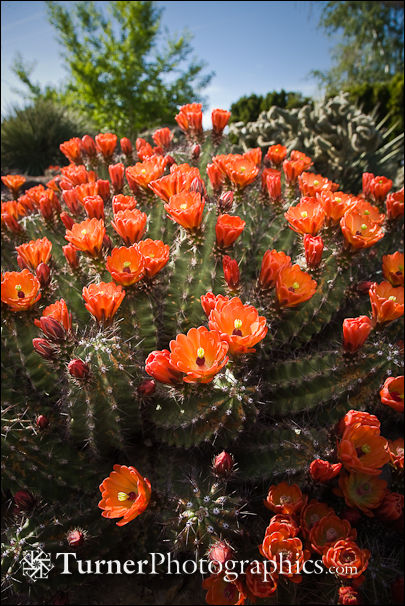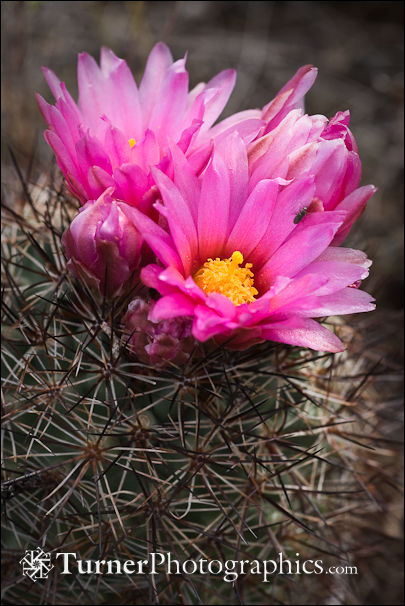Prickly Beauties
 Last weekend I made a 1000-mile road trip to see a bunch of plants. Most were in the wild, but I stopped in Yakima to see my friend Ron McKitrick’s Hillside Desert Botanical Garden.
Last weekend I made a 1000-mile road trip to see a bunch of plants. Most were in the wild, but I stopped in Yakima to see my friend Ron McKitrick’s Hillside Desert Botanical Garden.
Ron has the most incredible cactus garden you’ll find just about anywhere. He’s been growing cactus, which are native only to the Americas, for decades and has filled his back yard with these prickly beauties.
The photo here is of one of the most spectacular clumps in the garden, a Scarlet Hedgehog Cactus. You might know it as Echinocereus triglochidiatus var. octacanthus. But then again, cactus taxonomy seems to be in flux and the name may have changed. Anyhow, that’s what Ron calls it. You might find it growing in the wild in any of the southwestern states, but not up here in Washington.
Many of the southwestern cacti are perfectly hardy in northern climates, but they do need full sun, excellent drainage, and not too much rain. Ron did tell me that he lost a few last winter because temperatures dropped too fast in the fall and the plants didn’t have time to harden off.
You can see more photos of Ron’s garden on my Inland Northwest Gardening website. See Ron McKitrick in Yakima. The link will take you to my most recent visit, but you can browse from there to my other visits in previous years.
 Most folks don’t realize that we have cacti that are native to the northwest. This one, another Hedgehog Cactus, is Pediocactus nigrispinus, formerly known as Pediocactus simpsonii var. robustior. You’ll find it on rocky soils at selected locations in central Washington and eastern Oregon. This very nice specimen was growing on a ridge in the new Spring Basin Wilderness just southeast of the Clarno bridge on the John Day River.
Most folks don’t realize that we have cacti that are native to the northwest. This one, another Hedgehog Cactus, is Pediocactus nigrispinus, formerly known as Pediocactus simpsonii var. robustior. You’ll find it on rocky soils at selected locations in central Washington and eastern Oregon. This very nice specimen was growing on a ridge in the new Spring Basin Wilderness just southeast of the Clarno bridge on the John Day River.
I’d never heard of the Spring Basin Wilderness until I signed up for the Native Plant Society of Oregon Annual Meeting and chose it as a field trip destination. About a dozen of us hiked up a dry wash to a rocky ridge nearly 1000 feet above the John Day River. The cactus was growing in many places along the ridge and some of the plants were in spectacular full bloom like this one.
The trip was quite productive as I also saw and photographed two species of milkvetch I’d never seen before. Later in the day I shot a couple more plants that were new to me. That’s getting harder and harder to do so it’s always exciting. You can see more shots of the cactus, as well as the rest of my take for the day on my Pacific Northwest Wildflowers website under Spring Basin Wilderness.
As usual I carried a lot of photo gear and didn’t use it all. The garden shot was made with my 24-105 lens and a reflector to bounce sunlight into the dark recesses of the cactus stems. The backlight from the sun makes the blossoms glow. The Pediocactus was shot with a 100mm macro and a diffuser to soften the mid-day sun.


Hello Mark,
We enjoyed seeing your photos taken in the Spring Basin Wilderness, and that link led here to your blog. Glenn photographed this Hedgehog at the Painted Hills in 1991–then it was called Pediocactus simpsonii var. robustior. Earlier, when we lived in Utah, Glenn had photographed a WHITE pediocactus near Duchesne also called Pediocactus simpsonii var. robustior. He’s not surprised that the John Day area hedgehog was given a new name–the two cacti were fairly different.
We have a sad story about a wonderful specimen of this Hedgehog that we were guided to at the Painted Hills. A park ranger, seeing we were interested in photographing the hedgehogs, showed us this incredible plant–a mound between two and three feet across, and covered with these brilliant cerese-pink blossoms. We returned a year or two later and sought out this specimen–only to find it had been ripped from the soil, just a few forlorn pieces still scattered there. I guess the moral of the story is–if you know of something very special, don’t talk about it! I’m sure the park ranger regretted having probably told many visitors about this particular plant.
Thanks for sharing your fine photography!
Barbara and Glenn Halliday (who contributed an Opuntia fragilis (also from the Painted Hills) to your book, WILDFLOWERS OF THE PACIFIC NORTHWEST.
Barbara, it really is sad that people dig up plants from the wild to take home with them. Cacti seem to be particularly prone to predation, and unless given just the right conditions they’re likely to die in a garden. It’s much better to judiciously collect a little seed with land owner permission and start from the beginning. But we live in a world where we want instant gratification.